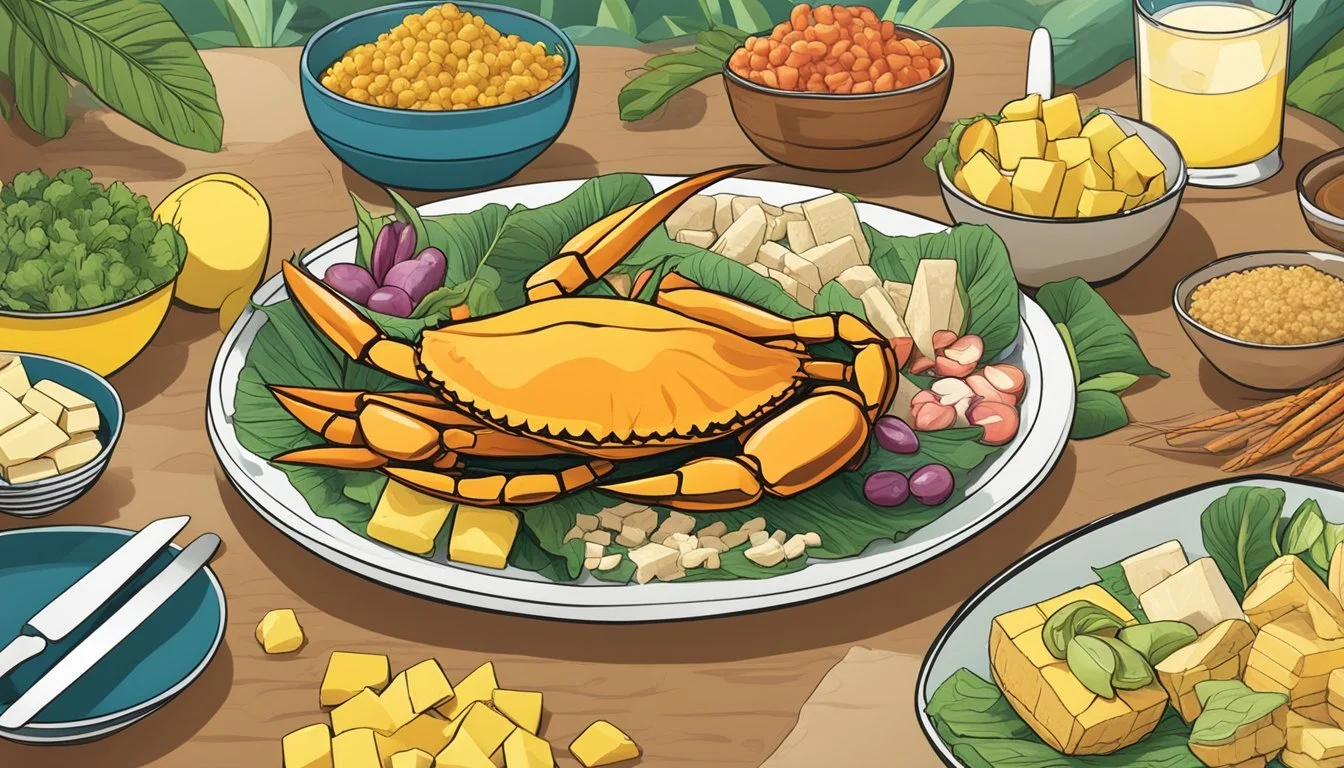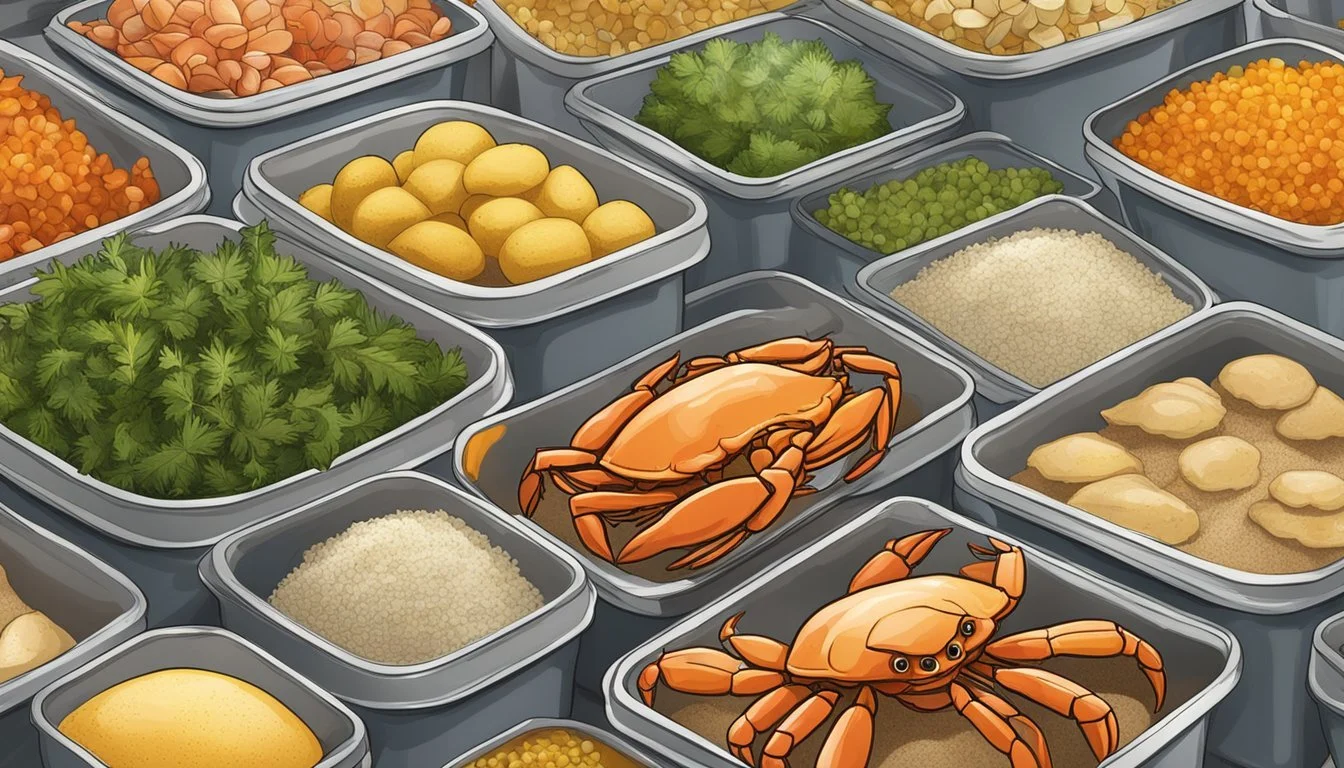Crab Substitutes
Top Alternatives for Seafood Lovers
For those seeking alternatives to crabmeat, there are numerous options that cater to different dietary preferences and health considerations. Jackfruit stands out as a popular vegan substitute due to its fibrous texture and ability to absorb seasoning, making it mimic crabmeat effectively. Available both fresh and canned, young green jackfruit in brine or water is the best choice for a more neutral flavor.
For those who prefer a seafood taste without the actual crab, shredded or flaked white fish like cod or haddock offers a great alternative. Firm tofu, when seasoned and cooked properly, can also replicate the texture and flavor of crabmeat, providing a versatile option for various recipes. Both of these substitutes bring a similar mouthfeel and can be used in dishes like salads and dips.
These substitutes are not only delicious but also align with sustainable eating practices. Choosing plant-based or responsibly-sourced fish options contributes positively to environmental health by reducing overfishing and the depletion of crab populations.
Understanding Crab Substitutes
Crab substitutes offer various alternatives for those seeking a different option due to dietary preferences, availability, or sustainability concerns. This section explores the types of substitutes, their nutritional profiles compared to real crab, and their culinary applications.
Varieties and Categories
Crab substitutes can be broadly categorized into seafood-based and plant-based options.
Seafood-based substitutes include imitation crab and surimi. Imitation crab, often made from fish like Alaska pollock, is designed to mimic the taste and texture of real crab. Surimi, a processed seafood product, also fits here.
Plant-based substitutes such as jackfruit and tofu are gaining popularity. Jackfruit, when seasoned properly, can replicate the flaky texture of crab. Tofu, when prepared correctly, can offer a versatile and protein-rich alternative.
These varieties cater to different dietary needs, including those avoiding seafood or looking for vegan options.
Nutritional Comparison with Real Crabmeat
Comparing the nutritional content of crab substitutes with real crabmeat is essential for informed dietary choices.
Nutrient Real Crabmeat Imitation Crab Jackfruit Tofu Protein (per 100g) 19g 7g 1.7g 8g Fat (per 100g) 0.5g 0.5g 0.3g 4.8g Calories (per 100g) 82 95 95 76
Imitation crab and other seafood-based substitutes tend to be lower in protein compared to real crab. Plant-based options like tofu offer a decent amount of protein, while jackfruit is relatively low in both protein and fat.
Culinary Usage
Seafood and plant-based crab substitutes can be used in various dishes to replicate the flavor and texture of crab.
Seafood-based options, such as imitation crab and surimi, are commonly used in sushi, salads, and seafood pasta. They are convenient, pre-cooked, and ready to add to cold or hot dishes.
Plant-based substitutes like jackfruit and tofu can be seasoned and cooked in ways that bring out a crab-like texture. Jackfruit works well in vegan crab cakes or tacos, while tofu can be used in stir-fries and vegan crab rangoon.
Selecting the right substitute involves considering the dish's flavor profile and texture requirements, as well as dietary needs and preferences.
Health Benefits and Dietary Preferences
Crab substitutes offer a variety of health benefits and cater to specific dietary preferences, making them suitable for vegans, vegetarians, individuals with gluten sensitivities, and those seeking low-cholesterol options.
For Vegans and Vegetarians
For those following vegan and vegetarian diets, jackfruit and firm tofu are excellent substitutes for crab meat. Jackfruit, when cooked and seasoned, mimics the texture of crab meat. It is low in calories and provides some fiber and vitamins, though it is not as high in protein as other substitutes.
Tofu, on the other hand, is a rich source of protein and can be manipulated to achieve the desired texture. It also offers essential minerals such as calcium and iron, making it a nutritious choice. These plant-based substitutes ensure that vegans and vegetarians get a versatile and health-conscious alternative to crab meat.
For Gluten-Free Diets
For those needing gluten-free options, imitation crab made from fish such as cod or haddock can be an excellent choice. These fish-based substitutes are naturally free from gluten and can be seasoned to taste like crab meat. They are rich in protein and omega-3 fatty acids, which are beneficial for maintaining heart health.
Another gluten-free option is firm tofu, which is versatile and gluten-free. Tofu contains protein, calcium, and potassium, contributing to a balanced diet. Ensuring that these substitutes are prepared without gluten-containing sauces or additives is key for those with celiac disease or gluten sensitivities.
For Low-Cholesterol Diets
Individuals seeking low-cholesterol substitutes can benefit greatly from plant-based options such as jackfruit and tofu. Jackfruit is naturally low in fat and contains no cholesterol, making it a heart-healthy alternative. It also offers dietary fiber which can aid in maintaining cholesterol levels.
Tofu once again stands out due to its low saturated fat content and zero cholesterol. Additionally, tofu provides essential nutrients like iron, calcium, and selenium. Both jackfruit and tofu offer substantial health benefits, making them suitable for those aiming to reduce their cholesterol intake while enjoying flavorful dishes.
Popular Crab Substitute Options
Crab substitutes can replicate the texture and flavor of real crab, making them suitable for various dishes. The options include both seafood and plant-based alternatives, each with unique preparation methods and availability characteristics.
Textural and Flavor Qualities
Tofu: Firm tofu can mimic the texture of crabmeat, especially when seasoned well. It has a mild flavor that absorbs seasonings effectively.
Jackfruit: When young, jackfruit has a fibrous texture similar to crab, and it can be seasoned to imitate its taste.
Hearts of Palm: The stringy texture of hearts of palm makes it a good substitute. Its mild flavor can be enhanced with proper seasoning.
Mushroom: Mushrooms, especially king oyster mushrooms, have a meaty texture. When shredded, they can mimic the consistency of crab.
Seitan: Made from wheat gluten, seitan has a firm texture. Its ability to absorb flavors makes it suitable for crab-like dishes.
Preparation and Cooking Techniques
Tofu: Can be marinated and then baked, grilled, or sautéed to achieve a crab-like texture.
Jackfruit: Should be cooked and seasoned to bring out its potential. It can be sautéed, baked, or used in stews and salads.
Hearts of Palm: Best when chopped or shredded. It can be used in cold dishes like salads or cooked in warm preparations.
Mushroom: King oyster mushrooms can be shredded and then sautéed with spices to resemble crabmeat.
Seitan: Can be marinated or seasoned, then grilled or sautéed to develop a depth of flavor similar to crab.
Availability and Shelf Life
Tofu: Widely available in most grocery stores. It has a refrigeration shelf life of about one week once opened.
Jackfruit: Available canned or fresh in specialty stores and larger supermarkets. Canned jackfruit lasts longer than fresh.
Hearts of Palm: Commonly found canned in supermarkets. They have a long shelf life when unopened but should be used within a week once opened.
Mushroom: King oyster mushrooms are typically available in Asian markets or specialty stores. They should be used within a few days of purchase.
Seitan: Readily available in health food stores and supermarkets. It has a refrigeration shelf life of about a week once opened.
Incorporating Substitutes into Crab Dishes
For those looking to replicate the unique flavor and texture of crab in their favorite dishes, several effective substitutes can be used. Options like jackfruit, white fish, and tofu offer versatility in a variety of recipes, ensuring that the essence of the dish remains intact.
Substitutes for Crab Cakes
Jackfruit and white fish, such as cod or haddock, can serve as excellent substitutes in crab cakes. Jackfruit’s firm texture mimics crab meat when cooked and seasoned well. It easily absorbs flavors, making it a plant-based alternative. White fish, on the other hand, can be flaked to resemble the texture of crab. It holds seasonings adeptly, ensuring the final product is flavorful. Tofu can also be used; when properly prepared and seasoned, it provides a satisfying texture and taste.
Substitutes for Crab Salad and Sushi
For salads and sushi, jackfruit and tofu are prominent choices. Jackfruit's mild flavor blends well with other ingredients in seafood salads. It can be marinated to enhance its taste, fitting seamlessly into dishes like sushi rolls and salads. Tofu, when firm and well-prepared, offers another viable option. It absorbs the flavors of the dressings and seasonings used, making it perfect for sushi and seafood salads. White fish can also feature in these dishes, delivering a familiar texture and taste for seafood lovers.
Creative Twists for Soups and Pasta
In soups, chowders, and bisques, white fish and tofu excel as substitutes. White fish provides substantial texture and holds up well in rich, creamy soups. Tofu can be diced or crumbled to add protein and texture to dishes like clam chowder or seafood bisques. For pasta dishes, including seafood pasta, jackfruit and tofu are versatile. Jackfruit’s ability to take on flavors ensures it complements pasta sauces effectively. Tofu, when cubed or crumbled, integrates well into seafood pasta and dips, maintaining the dish's essence while adding a plant-based component.
Incorporating these substitutes into crab-based recipes ensures a diversity of flavors while catering to dietary preferences and restrictions.
Seasoning and Flavor Enhancements
Proper seasoning and flavor enhancements are crucial when using crab substitutes to ensure the dishes are satisfying. This section will explore ways to mimic crab’s unique flavor and recommend herbs and spices that complement these substitutes effectively.
Mimicking Crab's Unique Flavor
To emulate the flavor of crab in substitutes, Old Bay Seasoning is highly recommended. This blend contains celery salt, paprika, black pepper, cayenne pepper, dry mustard, nutmeg, and other spices that bring a distinct seafood taste.
Lemon juice adds a refreshing acidity that brightens the flavors, making the substitute taste more like crab. Marinating substitutes like tofu or jackfruit in a mixture of lemon juice and Old Bay Seasoning for at least an hour helps infuse these flavors deeply.
Liquid smoke or a small amount of smoked paprika can provide a subtle smokiness that some crab dishes have. Combining these factors creates a more authentic seafood experience.
Herbs and Spices Complementing Substitutes
Several herbs and spices pair well with crab substitutes. Fresh herbs like dill, parsley, and chives add a mild yet fresh profile. These are particularly good in salads and cold dishes where subtlety is key.
Garlic and onion powder are versatile seasonings that add depth to the flavor of substitutes like white fish or tofu. These are ideal in cooked dishes where robust flavor is necessary.
Consider using bay leaves and celery seeds during cooking to evoke the fragrance of the sea. Adding red pepper flakes or cayenne pepper can introduce a bit of heat for those who prefer a spicy kick.
By combining these seasonings and herbs thoughtfully, the chosen crab substitutes will be both flavorful and satisfying.
Environmental Impact and Sustainability
Choosing crab substitutes over traditional crab meat can significantly alleviate the pressure on marine ecosystems. Such alternatives address the environmental concerns of overfishing and promote sustainable seafood choices.
Evaluating the Ecological Footprint
Crab harvesting often involves practices that strain ocean ecosystems. Overfishing can lead to depleted crab populations, disrupting marine life balance and affecting biodiversity. In comparison, many crab substitutes—like those made from plant-based ingredients or other fish species—tend to have a lower ecological footprint.
The production of imitation crab typically uses wild-caught fish like Alaskan Pollock, which is known for sustainable fishery practices. However, broader adoption of plant-based options can further reduce the environmental impact by minimizing the demand for marine catch.
Promoting Sustainable Seafood Choices
Selecting sustainable seafood options is crucial for long-term ocean health. Eco-friendly crab substitutes, when sourced responsibly, help mitigate overfishing. Plant-based alternatives not only decrease reliance on wild crab populations but often involve more sustainable agricultural practices.
Consumers play a vital role by choosing products with verified sustainability certifications. This encourages the industry to prioritize environmentally friendly methods, leading to healthier oceans. Additionally, supporting companies committed to transparent and ethical sourcing amplifies the positive impact on the environment.
Incorporating these insights into dietary choices can significantly support sustainable food systems and environmental preservation.
Budget-Friendly and Cost-Effective Alternatives
Crabmeat can be pricey, but there are several affordable substitutes to consider. These alternatives can provide a similar culinary experience without breaking the bank.
Comparing Prices and Value
Real crabmeat can cost up to $30 per pound, making it a luxury item for many. On the other hand, imitation crab, like surimi, is far more affordable at about $5 per pound. Despite its lower cost, imitation crab offers a close texture and flavor to real crabmeat, making it a popular choice.
White fish varieties, such as cod or haddock, serve as excellent replacements. They can be shredded or flaked and are usually less expensive. Firm tofu is another versatile and cost-effective substitute, ideal for mimicking the texture of crab in various recipes.
Tips for Economical Shopping
When looking for crabmeat substitutes, it's important to keep a few strategies in mind. Buying in bulk can substantially cut down costs. Many stores offer discounts on larger quantities, making it a budget-friendly option.
Seasonal shopping is another great tip. Prices of seafood alternatives often drop during peak seasons, allowing consumers to stock up at a lower cost. Checking for sales and discounts can also help, as many grocery stores offer deals on seafood and its substitutes.
Opting for store brands over name brands can result in significant savings. Store-brand products often provide the same quality at a fraction of the price. Utilizing online marketplaces can also provide opportunities for finding budget-friendly deals on crabmeat and its alternatives.
Storage and Preparation
Proper storage and preparation of crab substitutes ensure quality and nutrient preservation. Attention to detail during storage can extend shelf life, while tailored cooking techniques enhance texture and flavor.
Preserving Substitute Ingredients
To maintain freshness, store substitutes like tofu, white fish, and jackfruit in air-tight containers. Refrigerate tofu and white fish at below 40°F (4°C), using them within 3-5 days. For longer storage, tofu can be frozen for up to 3 months, though it may alter its texture.
Canned jackfruit should be stored in a cool, dark place and consumed by the expiration date. Once opened, refrigerate and use within 5-7 days. Ensure good air circulation in your fridge to prevent spoilage. When freezing cooked substitutes, use vacuum-sealed bags to maintain nutrients and flavor.
Prep Work and Cooking Tips
For an authentic crab texture, season and cook each substitute according to its unique properties. Sauté imitation crab in a skillet with a bit of oil for 2-3 minutes. Steaming it for 3-4 minutes also works well.
White fish should be flaked and cooked until opaque and firm, which typically takes 4-5 minutes per side in a skillet. Firm tofu benefits from marinating for at least 30 minutes to absorb flavors, then baking at 375°F (190°C) for 25-30 minutes until golden. Jackfruit can be sautéed or simmered in sauces to absorb flavors.
By following these guidelines, the perfect balance of texture and flavor can be achieved for crab substitutes.
Concluding Thoughts on Crab Substitutes
Crab substitutes offer a range of health and nutritional benefits suitable for various dietary preferences. These options ensure that those with seafood allergies, vegan lifestyles, or health-conscious diets can still enjoy dishes often associated with crab.
Nutritional Benefits: Many crab substitutes such as white fish and tofu are high in protein while being low in fat. For those seeking more fiber, jackfruit and artichoke hearts make excellent choices.
Dietary Preferences: Options like heart of palm and jackfruit specifically cater to vegan and vegetarian diets. These alternatives retain a texture and flavor reminiscent of crab meat when cooked and seasoned correctly.
Health Benefits: Plant-based substitutes like jackfruit and artichoke hearts are rich in fiber, aiding digestion. Additionally, they offer various vitamins and minerals essential for a balanced diet.
Seafood Options: Traditional seafood-based alternatives, such as mock crab made from fish like cod or haddock, provide the taste and texture of crab while maintaining the benefits of seafood.
Below is a brief comparison of some popular crab substitutes:
Substitute Protein Fat Fiber Dietary Suitability White Fish High Low Low Pescatarian Jackfruit Moderate Low High Vegan Heart of Palm Moderate Low Moderate Vegan Tofu High Low Moderate Vegetarian/Vegan Mock Crab High Low Low Pescatarian
Choosing a crab substitute depends on individual dietary needs and preferences. With a variety of options, anyone can find a suitable alternative that meets their nutritional requirements.








